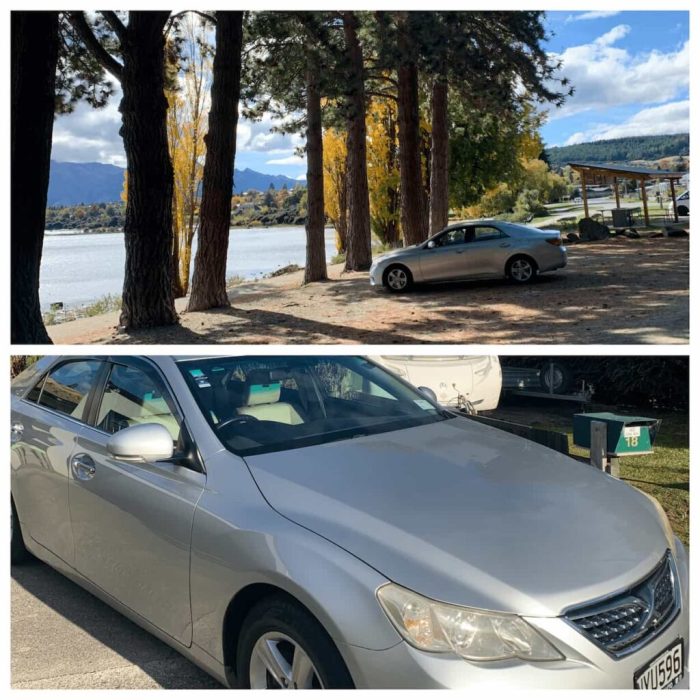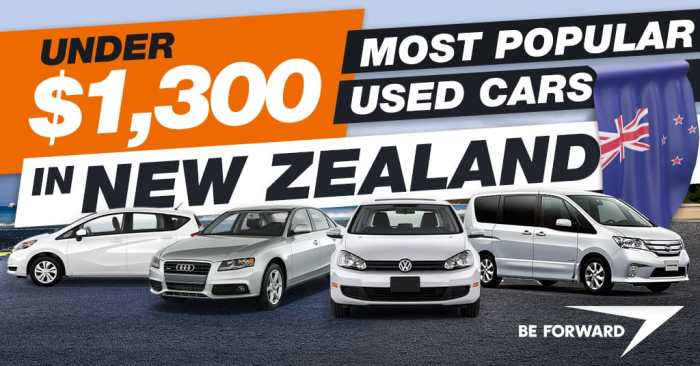Used Car Price in New Zealand A Comprehensive Guide
Factors Influencing Used Car Prices in New Zealand
Used car price in new zealand – Several interconnected factors influence the price of used cars in New Zealand. These range from broad economic conditions to specific government regulations and the condition of individual vehicles. Understanding these factors is crucial for both buyers and sellers navigating the used car market.
Top Economic Factors Impacting Used Car Prices
Three key economic factors significantly influence used car prices: inflation, interest rates, and overall consumer confidence. High inflation erodes purchasing power, potentially lowering demand for used cars unless prices adjust accordingly. Increased interest rates make financing more expensive, impacting affordability and potentially reducing demand. Low consumer confidence generally translates to less spending on discretionary items like used vehicles.
Import Regulations vs. Domestic Market Fluctuations
Import regulations, particularly those related to vehicle age and emissions standards (like the Clean Car Standard), directly impact the supply of used cars available in New Zealand. Stricter regulations can limit the number of imported used vehicles, potentially driving up prices. Domestic market fluctuations, such as changes in new car sales or economic downturns, also influence the used car market, often creating a ripple effect on pricing.
Seasonal Changes and Used Car Demand
Seasonal changes demonstrably affect used car demand and prices. Typically, demand increases during the spring and summer months, as people are more likely to undertake road trips and other outdoor activities. This increased demand can push prices upward. Conversely, demand often softens during the autumn and winter months, leading to potentially lower prices.
Impact of Government Policies
Government policies, particularly the Clean Car Discount and the Clean Car Standard, significantly influence used car values. The Clean Car Discount incentivizes the purchase of low-emission vehicles, increasing demand and potentially the price of eligible used cars. Conversely, the Clean Car Standard impacts the import and sale of higher-emission vehicles, potentially reducing their value and making them harder to sell.
Price Variations Across Car Makes and Models
| Make & Model | Average Price (NZD) | Age (Years) | Mileage (km) |
|---|---|---|---|
| Toyota Corolla (2018) | $18,000 – $22,000 | 5 | 80,000 – 100,000 |
| Mazda3 (2019) | $20,000 – $25,000 | 4 | 70,000 – 90,000 |
| Ford Ranger (2020) | $35,000 – $45,000 | 3 | 60,000 – 80,000 |
| Mitsubishi Outlander (2017) | $15,000 – $20,000 | 6 | 90,000 – 120,000 |
Regional Price Variations
Used car prices vary considerably across different regions of New Zealand. Several factors contribute to these regional differences, including supply and demand dynamics, local economic conditions, and the prevalence of specific car models in each area.
Price Comparisons Across Major Cities
Auckland, as the largest city, generally sees higher used car prices compared to Wellington and Christchurch due to higher demand and a larger pool of potential buyers. Wellington and Christchurch often have more competitive pricing, although specific models can still exhibit price fluctuations based on local market conditions.
Used car prices in New Zealand can fluctuate widely depending on make, model, and condition. If you’re considering a more affordable option, comparing prices to the cost of a new vehicle might be helpful. For instance, checking the current prices for a new Suzuki, by visiting this website for suzuki new car price , can give you a benchmark.
This comparison can help you better understand the value proposition of buying used in the New Zealand market.
Urban vs. Rural Price Differences
Used car prices tend to be higher in urban areas due to higher demand and easier access to a wider selection of vehicles. Rural areas often have lower prices, but the selection might be more limited, and buyers may need to travel further to find suitable vehicles.
Regional Price Discrepancies for Specific Models
- Toyota Hilux (2015): Auckland: $25,000 – $30,000; Wellington: $22,000 – $27,000; Christchurch: $20,000 – $25,000.
Condition and Mileage Impact
The condition and mileage of a used car are major determinants of its price. Higher mileage and signs of wear and tear typically translate to lower prices, while well-maintained vehicles with low mileage command higher values.
Condition’s Impact on Price, Used car price in new zealand
A used car’s condition, encompassing factors such as wear and tear, accident history, and maintenance records, significantly influences its resale value. Cars with documented accident history or significant mechanical issues will generally sell for considerably less than comparable vehicles in excellent condition.
Mileage’s Effect on Resale Value
High mileage generally indicates more wear and tear on a vehicle’s components. While some cars can handle high mileage well, it often leads to lower resale value compared to low-mileage counterparts of the same make and model. This effect is often more pronounced in older vehicles.
Price Difference: High vs. Low Mileage
A high-mileage Toyota Camry (2015) with 200,000 km might sell for $8,000 – $12,000, while a low-mileage version (50,000 km) of the same model could fetch $15,000 – $20,000, illustrating the significant impact of mileage on price.
Depreciation Rate Based on Mileage and Age
| Age (Years) | Mileage (km) | Estimated Value (NZD)
|
|---|---|---|
| 3 | 50,000 | $16,000 – $18,000 |
| 5 | 100,000 | $12,000 – $14,000 |
| 7 | 150,000 | $8,000 – $10,000 |
Online Marketplaces and Pricing: Used Car Price In New Zealand
Online marketplaces have significantly impacted the used car market in New Zealand, offering buyers greater choice and transparency. However, understanding the nuances of pricing across different platforms is crucial.
Price Comparisons Across Online Platforms
Popular online marketplaces like Trade Me, Driven, and Carsales often show variations in average prices for the same vehicle. These variations can stem from differences in seller demographics, vehicle condition disclosure, and the overall competitiveness of each platform.
Online vs. Traditional Dealership Pricing

Source: simplenewzealand.com
Online platforms often offer more competitive pricing compared to traditional dealerships due to lower overhead costs. However, the lack of in-person inspection and potential for scams necessitates extra caution when buying online.
Pricing Strategies Across Online Platforms

Source: beforward.jp
Different online platforms may employ varying pricing strategies. Some may prioritize showcasing higher-priced vehicles, while others might focus on a wider range of price points. Understanding these platform-specific nuances is important for effective price comparisons.
Advantages and Disadvantages of Buying Online vs. Dealership
- Online: Advantages – wider selection, potentially lower prices, convenience; Disadvantages – lack of in-person inspection, higher risk of scams, limited warranty options.
- Dealership: Advantages – in-person inspection, warranty options, established reputation; Disadvantages – potentially higher prices, less selection.
Visual Representation of Price Trends
Analyzing used car price trends requires a visual approach to effectively communicate complex data. Graphs and charts can reveal patterns and relationships that are not easily discernible from raw data alone.
Five-Year Price Trend
A line graph illustrating the average price of used cars in New Zealand over the past five years would likely show fluctuations reflecting economic cycles and government policy changes. Periods of economic growth might correlate with higher prices, while downturns could show a decrease in average prices. The introduction of the Clean Car Standard could also be reflected as a potential shift in the trend.
Car Age and Price Depreciation
A scatter plot showing the relationship between car age and price depreciation would typically illustrate a negative correlation. As a car gets older, its value generally decreases, although the rate of depreciation can vary depending on make, model, and condition. The graph would likely show a steeper initial decline in value followed by a more gradual decrease over time.
Regional Price Variation of a Specific Model
A bar chart comparing the average price of a specific car model (e.g., Toyota Corolla) across different regions of New Zealand would visually highlight regional price differences. Auckland might show the highest average price, followed by Wellington and then Christchurch, reflecting the impact of factors like population density and demand.
FAQ Resource
What is the average age of used cars sold in New Zealand?
The average age varies depending on the region and vehicle type but generally falls within the 5-10 year range.
Are there any specific websites or resources for checking used car prices in New Zealand?
Yes, several websites such as Trade Me Motors, Driven.co.nz, and reputable dealership websites offer listings and pricing information.
How can I verify the history of a used car in New Zealand before purchasing?
You can obtain a vehicle history report through services like VTNZ (Vehicle Testing New Zealand) to check for accident history, mileage discrepancies, and other important details.
What are the typical negotiation strategies when buying a used car in New Zealand?
Research comparable listings, identify potential issues with the vehicle, and be prepared to negotiate based on the car’s condition and market value. A pre-purchase inspection by a mechanic is advisable.




















